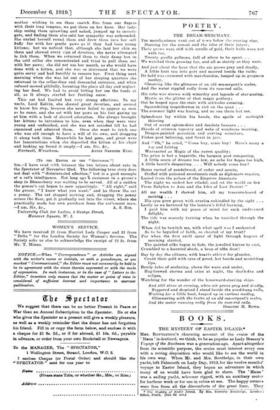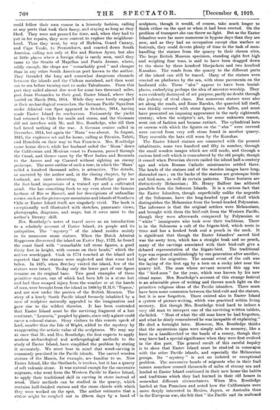BOOKS.
THE MYSTERY OF EASTER LSLAND.* Mae. Rorrrizoax's charming account of the cruise of the Mans ' is destined, we think, to be as popular as Lady Braesey's Voyage of the Sunbeam was a generation ago. Apart altogether from its scientifio purpose, the cruise must interest every one with a roving disposition who would like to see the world in his own way. When Mr. and Mrs. Routledge, in their own yacht, left Falmouth on Lady Day, 1913, for the twelve months' voyage to Easter Island, they began an adventure in which many of us would have been glad to share. The ' Maria' was a sailing yacht, schooner rigged, with an auxiliary motor for harbour work or for use in calms at sea. The happy owners were free from all the discomforts of the great liner. They • The Mystery of Easter reonci. fly Mrs. Scoresby Eoutledge. London : 8ifton, Praed, [811. 6d. net.i could follow their own course in a leisurely fashion, calling at any ports that took their fancy, and staying as long as they liked. They were not pressed for time, and, when they had to put in for repairs, they were content to explore the neighbour- hood. Thus they went, by way of Madeira, Grand Canary, and Cape Verde, to Pernambuco, and coasted down South America, calling not only at Rio and Buenos Ayres, but also at little places where a foreign ship is rarely seen, until they came to the Straits of Magellan and Punta Arenas, where, oddly enough, the shops are " remarkably good " and cheaper than in any other South American port known to the author. They threaded the long and somewhat dangerous channels between the islands and the Chilean mainland, and then went out to sea before turning east to make Talcahuano. From this port they sailed almost due west for some two thousand miles, past Juan Fernandez to their goal, Easter Island, where they landed on March 29th, 1914. While they were busily engaged in their archaeological researches, the German Pacific Squadron under Admiral von Spec appeared in October, 1914, having made Easter Island its rendezvous. Fortunately the yacht had returned to Chile for mails and stores, and the Germans did not interfere with Mr. and Mrs. Routledge, who till then had heard nothing of the war. A German cruiser called in December, 1914, but again the Mann' was absent. In August, 1915, the explorers set sail for home, calling at Pitcairn, Tahiti, and Honolulu on their way to San Francisco. Mrs. Routledge came home direct, while her husband sailed the Mana ' down the Californian and Mexican coast to Panama, passed through the Canal, and thence came by the West Indies and Bermuda to the Azores and up Channel without sighting an enemy periscope. The mere outline of such a tour, in which the Mann' sailed a hundred thousand miles, is attractive. The details, as narrated by the author and, in the closing chapter, by her husband, are most interesting. Mrs. Routledge gives us the first-hand impressions of a trained eye and a cultivated mind. She has something fresh to say even about the famous harbour of Rio or Hawaii, and her descriptions of unfamiliar scenes, such as the picturesque mountains and islands of Southern Chile or Easter Island itself, are singularly vivid. The book is exceptionally well illustrated with sketches, panoramic views, photographs, diagrams, and maps, but it owes most to the author's literary skill.
Mrs. Routledge's notes of travel serve as an introduction to a scholarly account of Easter Island, its people and its sntiquities. The " mystery " of the island resides mainly in its numerous stone statues. When the Dutch Admiral Roggeveen discovered the island on Easter Day, 1722, he found the coast lined with "remarkable tall stone figures, a good thirty feet in height, with crowns on their heads," which the natives worshipped. Cook in 1774 touched at the island and reported that the statues were neglected and that some had fallen. In 1825, when Beechey visited the island, few of the statues were intact. To-day only the lower part of one figure remains on its original base. Two good examples of these primitive statues, one of which had been left in a stone but and had thus escaped injury from the weather or at the hands of man, were brought from the island in 1868 by H.M.S. ' Topaze,' and are now under the portico of the British Museum. The story of a lonely South Pacific island formerly inhabited by a race of sculptors naturally appealed to the imagination and gave rise to the wildest theories. It has been contended that Easter Island must be the surviving fragment of a lost continent, " Lemuria," peopled by giants, since only a giant could carve a colossal statue. Stray visitors to this remote speck of land, smaller than the Isle of Wight, added to the mystery by exaggerating the artistic value of the sculptures. We may say at once that Mr. and Mrs. Routledge, the first experts to apply modern archaeological and a'ithropological methods to the study of Easter Island, have simplified the problem by stating it accurately. We must bear in mind that wood-carving is commonly practised in the Pacific islands. The carved wooden statues of the Maoris, for example, are familiar to us. Now Easter Island, like the Shetlands, is treeless, but it has a quarry of soft volcanic stone. It was natural enough for the successive migrants, who went from the Western Pacific-to Easter Island, to apply their traditional skill in carving in stone instead of wood. Their methods can be studied in the quarry, which contains half-finished statues and the stone chisels with which they were worked on the spot. The author estimates that a statue might be roughed out in fifteen days by a band of
sculptors, though it would, of course, take much longer to finish either on the spot or when it had been erected. On the problem of transport she can throw no light. But as the Easter Islanders were far more numerous in bygone days than they are now, and as they had no occupation except clan warfare or festivals, they could devote plenty of time to the task of man- handling the statues from the quarry to their chosen sites. The large British Museum specimen, standing eight feet high and weighing four tons, is said to have been dragged down to the shore by three hundred bluejackets and two hundred Kanakas. The roads from the quarry to the different parts of the island can still be traced. Many of the statues were erected on platforms by the sea, with stone pavements on the landward side. These "ahu" appear to have been burial- places, embodying perhaps the idea of ancestor-worship. They were evidently destroyed of set purpose, partly no doubt through the jealousy of rival clans. But numerous statues were also set along the roads, and Rano Raraku, the quarried hill itself, was thickly covered with stone figures, now fallen, and must have presented an imposing appearance in the early eighteenth century, when the sculptor's art, for some unknown reason, went out of fashion and became extinct. The cylindrical hats or crowns with which the figures on the " ahu " were covered were carved from very soft stone found in another quarry. They resemble the hats still worn by the Kanakas.
The Easter Island statues are connected with the present inhabitants, some two hundred and fifty in number; through the small wooden images which are still made, and through a curious bird-cult which is remembered by the old people, though it ceased when Peruvian slavers raided the island half-a-century ago and when Roman Catholic missionaries settled there. The heads of the statues and of the wooden images have long, distended ears ; on the backs of the statues are grotesque birds and bird-men, as well is certain patterns. These features are distinctively Melanesian ; Mr. Henry Balfour has adduced parallels from the Solomon Islands. It is a curious fact that the Easter Islanders, though superficially unlike the negroids of the Solomons, have the long-headed type of skull which distinguishes the Melanesian from the broad-headed Polynesian. The inference is that the original settlers were Melanesians, and brought with them the bird-cult from the Western Pacific, though they were afterwards conquered by Polynesian or " white " immigrants who took over their traditions. There is in the Solomons a cult of the frigate-bird, which nests in trees and has a hooked beak and a pouch in the neck. It is significant that though the Easter Islanders' sacred bird was the sooty tern, which has a straight beak and no pouch, many of the carvings associated with their bird-cult give a debased representation of the frigate-bird. The traditional type was repeated unthinkingly by one generation after another, long after the migration. The annual event of the cult was the laying of the first egg by a tern on a rocky islet near the quarry hill. The man whose servant secured this egg was the " bird-man " for the year, which was known by his new ritual name. Mrs. Routledge's account of this strange festival is an admirable piece of writing and throws much light on the primitive religious ideas of the Pacific islanders. There must have been some connexion between the bird-cult and the statues, but it is now forgotten. There existed also in Easter Island a system of picture-writing, which was practised within living memory. But though Mrs. Routledge tried hard to induce a very old man to interpret one of the surviving written tablets, she failed. Most of what the old man knew he had forgotten, and what he dimly remembered he was incapable of explaining." He died a fortnight later. However, Mrs. Routledge thinks that the mysterious signs were simply aids to memory, like a knot in a handkerchief or the beads of a rosary, though they may have had a special significance when they were first evolved in the dim past. The general result of this careful inquiry is to show that Easter Island must be studied in c,onneasion with the other Pacific islands, and especially the Melanesian groups. Its " mystery " is not an isolated or exceptional problem. The successive bands of migrants who in their frail canoes somehow crossed thousands of miles of stormy sea and landed at Easter Island continued in their new homelhe habits and traditions which they had learned in their old homes in somewhat different circumstances. When Mrs. Routledge landed at San Francisco and noted how the Californians were more deeply interested in Mexico, Japan, or Australia than in the.European war, she felt that " the Pacific and its seaboard
are really an entity, however much the atlas may prefer to give a contrary impression." The remark bears on the " mystery " of -Easter Island, which will probably be elucidated still further by researches on the other side of the Pacific.
















































 Previous page
Previous page